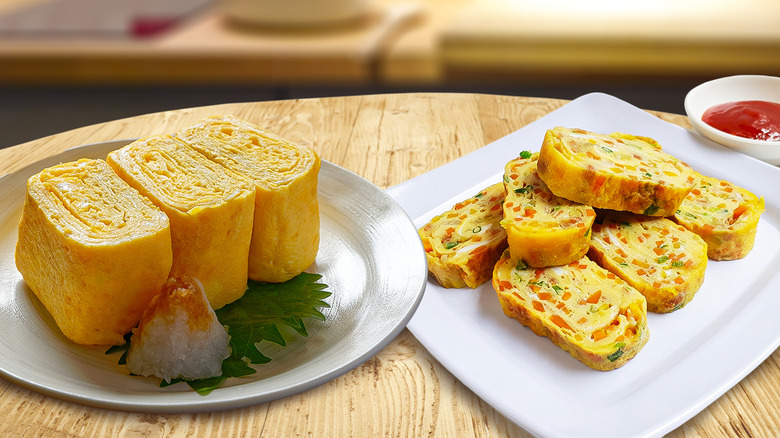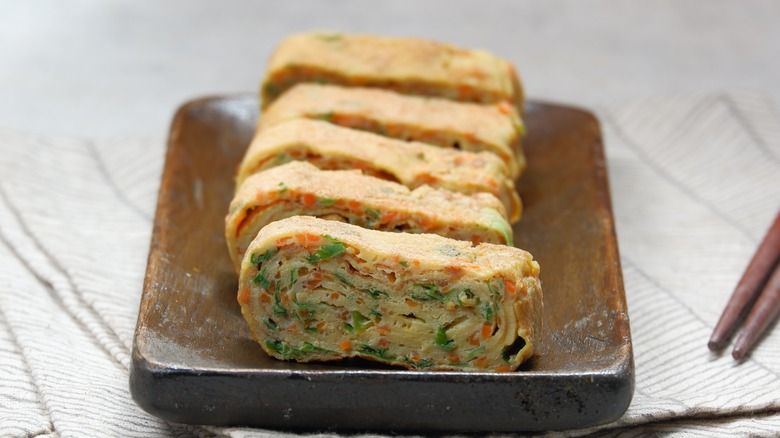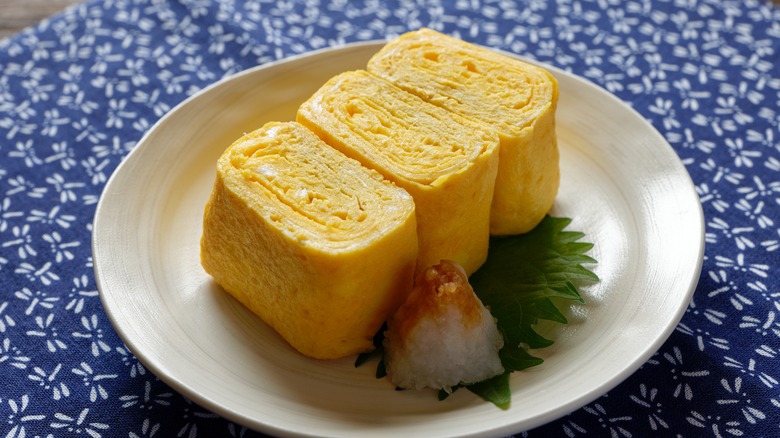Tamagoyaki Vs Korean Rolled Eggs: Is There A Difference?
Eggs are a simple dish, but the many ways that different parts of the world prepare eggs prove there are no limits to cooking them. There is more than one way to make an omelet, specifically, too. In Korea and Japan, versions of omelets exist in which eggs get cooked in thin layers and rolled into a neat rectangle. Korea's version of rolled eggs is called gyeran-mari, while in Japan it's called tamagoyaki. Although the dishes utilize the same cooking method that creates fluffy, layered eggs, some key ingredients differentiate the two.
In order to achieve the quintessential rectangular shape and layers of a rolled omelet, tamagoyaki and gyeran-mari are often cooked in rectangular pans. Just enough of the beaten eggs get poured onto the pan in a thin layer, which cooks quickly, gets folded into itself, and is pushed to one end of the pan. Then, in the remaining pan space, another thin layer of eggs gets poured, and the omelet is rolled up even further. In this manner, additions of eggs build the tamagoyaki and Korean rolled omelets into many layers. The result is a rectangular omelet that gets cut into bite-sized pieces. Structurally, tamagoyaki and Korean rolled gyeran-mari are very similar, but their flavor profiles make these two egg dishes unique.
Korean rolled eggs are savory
Korean rolled gyeran-mari is a simple egg dish commonly served as a side, or banchan, to more hefty Korean meals. At its core, gyeran-mari has many similarities to a typical American omelet you may make or order for breakfast. It has eggs, a pinch of salt and pepper, and various vegetables or ham. Gyeran-mari focuses on the savory and the salty, it benefits from the slight crunch of vegetables, and it preserves the fluffiness of eggs in its neatly rolled presentation.
It's one of those dishes that practically every Korean household makes, but each in a slightly different way. The beauty of gyeran-mari is all of the different ingredients it can include. One version of the dish might contain onions and red and green bell peppers, another could have carrots and ham, and yet another might feature green onion. Just toss in any vegetables you might find in the fridge — no need for specialty Korean ingredients. Although it is commonly served as a side dish, Korean rolled eggs also make for a filling meal on their own. Gyeran-mari is balanced, compact, and delicious, so it's a common dish for a work or school lunch box (dosirak).
Tamagoyaki is an ode to eggs
In contrast to the savory and veggie-filled Korean rolled omelet, Japan's tamagoyaki is more of an ode to the egg itself. Tamagokai doesn't typically contain many vegetables or much meat, only a few flavor-boosting ingredients. Soy sauce and either mirin or rice wine are the staples that add savory depth to the dish. Another optional ingredient to further enhance the omelet's flavor is dashi stock, a soup stock used to make the broth base for miso and other Japanese soups.
Yet the dish is not solely savory. Tamagoyaki isn't complete without a subtle spoonful of sugar, which helps balance the eggs in a sweet and savory medley while bringing out a custard-like flavor. Tamagoyaki is often served with the common Japanese condiment shredded daikon (radish) to add extra crunch and freshness. Tamagoyaki can be eaten throughout the day, but many people enjoy it as a light and filling breakfast. Like the Korean rolled omelet, tamagoyaki also makes for a convenient lunch box meal or side. You might find tamagoyaki at a sushi restaurant, where it is traditionally served after the meal, but look for tamago sushi on the menu, too; instead of a slice of fish, you'll find a slice of tamagoyaki over rice.


